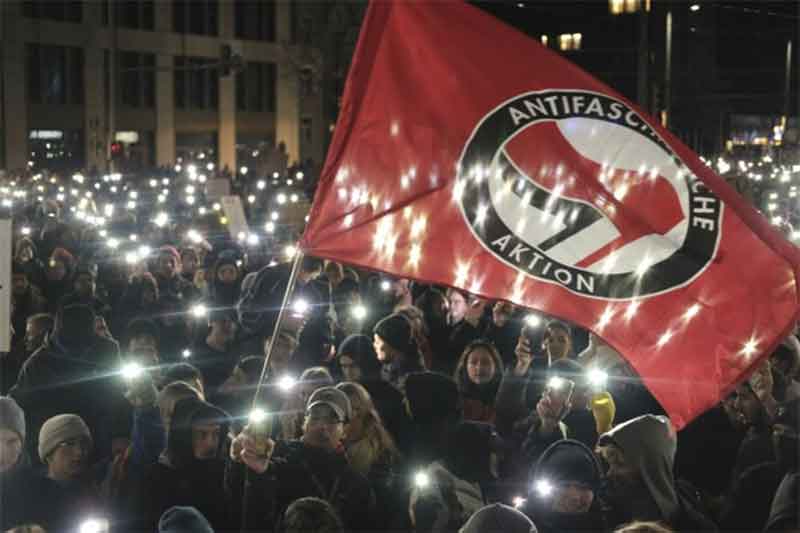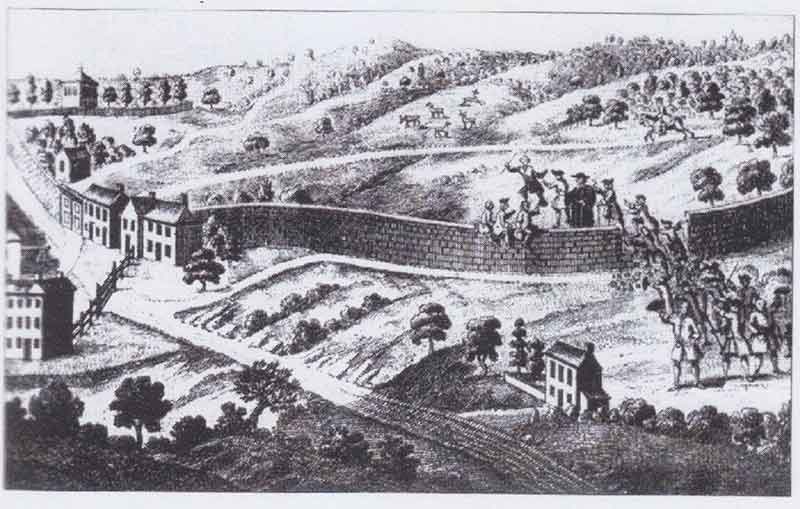
Germany has been in the grip of mass anti-far-right rallies ever since the first demonstration took place in Berlin on 14 January 2024.
Today there have been well over 3.5 million participants and there seems to be no end in sight. A recent rally in the Bavarian city of Munich had up to 100,000 people. While on 25th of February, 60,000 protested in Germany’s northern city of Hamburg.
The mass rallies against the far-right, Neo-Nazis, and their political party, the neo-fascist AfD, took place all over Germany – including 17,000 people in my birthplace. New rallies are planned for weeks to come.
The reaction by Germany’s far-right AfD to the anti-Neo-Nazi rallies are as expected. The AfD claims:
- that photos of mass rallies and numbers of participants are fake;
- rally participants have been paid to attend;
- rally attendants are Nazis;
- it is a dirt campaign against the AfD; demonstrations are organized by left-wing terrorists;
- these are Stasi methods; and so on.
The reaction of the AfD about the mass rallies against the far-right show that these anti-far-right demonstrations have made the AfD extremely nervous. But what do we – in general – know about the connection between protests and election results.
In other words, will the mass rallies have an impact on the AfD’s poll numbers? And will they have a recognizable impact on the upcoming European elections as well as three elections in the East-German states of Brandenburg, Saxony, and Thuringia.
Perhaps an early success of the rallies can be seen when the AfD candidate Uwe Thrum, for example, lost the election to the district council in the Saale-Orla in eastern Thuringia.
Beyond that, there is also a certain tension among AfD apparatchiks. The impact is also noticeable inside the AfD’s parliamentarian faction in Germany’s parliament, the Bundestag.
The AfD mini-Führer, Swiss resident, racist email sender, and Goldman Sachs’ former employee Alice Weidel and her simple-minded, small business owner and member of Bundestag Tino Chrupalla recently invited a selected few to the state-financed members’ restaurant inside Germany’s parliament – the Bundestag – to discuss the AfD’s response to the mass rallies.
At the state-financed meeting, the party agitates against corrupt politicians; well-paid AfD politicians had salmon snacks and good wine; and a musical trio played in the background. From their location, one can see where hundreds of thousands recently demonstrated against the far-right and the AfD.
A few hours earlier, mini-boss Weidel gave a speech in the parliament that observers have called the “most hateful thing they have experienced in the parliament”.
Hate speech fancying Weidel announced the nonsensical claim, “this government hates Germany”. Later, she used her tailor-made screams in Germany’s parliament for TikTok-propaganda. Weidel shouted in the direction of the government.
The pretty face of fascism who can officially be called a Nazi-bitch, conjured up the usual right-wing populists propaganda of the Biblical “The End Is Nigh” when speaking of Germany being on the path of devastation. For her, Germany’s federal government is guilty.
She also insinuated that the anti-AfD rallies are the result of an “unprecedented smear campaign against the AfD”.
The message to her party’s faithfuls (read: faith-fools) was clear, her AfD will attack its opponents – especially now. Meanwhile and this came despite the mass rallies of millions against the AfD, AfD apparatchiks tried to appear to be in a good mood – at least to the outside world.
The good mood was suddenly destroyed when Bayern Munich’s soccer super star Uli Hoeneß declared his dislike of the AfD.
Increasingly, German media is challenging the AfD by asking rather uncomfortable questions on, for example, the secretive Potsdam meeting of AfD politicians that planned the mass deportation of millions. Being asked uncomforting questions, is not AfD’s home ground.
As long as the talk centers on a conjured-up enemy – migration, refugees, and foreigners – the AfD is winning. The reverse is also true: any other issue is damaging to the AfD, including putting the spotlight onto the AfD itself.
Beyond all that, the question remains, will the months long anti-AfD mass rallies of millions harm the AfD’s standing in the polls and in upcoming elections?
Secondly, to what extent will they have an impact on AfD functionaries who were – since years – downright drunk with power?
While campaigning against the state, crooked democratic parties, and the supposedly corrupt democracy, AfD apparatchiks have lavished themselves on state money in lieu of skyrocketing public poll numbers.
By the end of 2023, the AfD even spoke of the absolute majority and the division of ministries when it comes to the upcoming state elections in Saxony, Thuringia, and Brandenburg. More recently, however, the mood has become much more muted.
With a downward trend of minus 3%, AfD’s crypto-Gruppenführer – Stephan Brandner – initially refused to believe that the AfD would lose the aforementioned election in Saale-Orla. Yet, it did. Most likely, the AfD would not have lost if it were not for the waves and waves of mass protests.
Nevertheless, AfD apparatchiks remain optimistic with some fearing that the AfD would crumble below their magical 20% in election polls. By early March 2024, all of Germany’s public polling agencies had the AfD between 17% and 19%.
Perhaps the AfD’s target of 20% carries some historical connotations. One of the most astute observers of Nazi-Germany – Sebastian Haffner – mentioned exactly a 20% margin in 1941 eye-witness account of, Germany: Jekyll and Hyde – An Eyewitness Analysis of Nazi Germany. Then as today, it appears as if Nazism has a 20% support base in Germany.
Meanwhile, some more realistic AfD apparatchiks have come to think that their goal of 20% is “not sustainable” in the long run.
At the same time, the AfD’s European election top candidate and master-demagogue Maximilian Krah fantasizes that the anti-AfD protests had “hardly any effect”.
True to his far-right propaganda skills, he also speaks of a “mobilization of the left”. Of course, for the Uber-authoritarian AfD, anyone supporting democracy is on the hard left.
Yet, he was also forced to agree that that the mass rallies against the AfD “probably complicates our further growth”. Behind the scenes, some AfD politicians talk of a Führungsschwäche – a weak and pathetic leadership, the AfD has yet to produce a Hitler-like Führer. Fortunately, none of the AfD’s trio leader is up to the job:
- the nice-looking and awfully bitchy Weidel isn’t really part of the domineering völkische Neo-Nazi wing;
- the obedient and naïve Chrupalla, who features as the official AfD boss is entirely unsuitable; and finally,
- the AfD’s baby-faced and internal would-like-to-be Führer Björn Höcke has too many party-internal enemies that shy away from the outspoken Neo-Nazi who used to write under the camouflaging name of Landolf Ladig.
With no clear Führer in sight, some inside the AfD have been making a big fuss about the rallies. Yet, there is next to no discussions about the mass rallies in AfD meetings.
The AfD sees it as a problem that can be faced by Aussitzen – ignoring it until it goes away. Yet, the AfD can ill-afford to ignore the strong headwinds coming from recent rallies.
One of the most recent public polls suggest that the AfD support has fallen by 3% since the beginning of the year. Yet, this should be treated with caution.
At the same time, the Sahra Wagenknecht alliance’s newly founded BSW party is a real challenge for the AfD. In the East-German state of Saxony, for example, the AfD has remained stable – so far.
The far-right party continues to stand at 34% – yet there has been a 1% decline. With 45 seats, the AfD would outflank the conservative CDU (41 seats).
In other words, the conservative-neo-fascist block of CDU and AfD would have 85 of the 120 seats (71%). The progressive would be utterly destroyed. Saxony’s next elections are set for the 1st of September 2024.
At the same time, the mass protests against the AfD have put the AfD on notice. Increasingly, the party needs to explain itself – even though AfD supports are lulled by propaganda, and not by rational arguments and logic.
Still, the AfD’s preferred narrative has been that it represents the so-called silent majority. With millions protesting against the AfD, the hallucination of the AfD to represent the silent majority is getting cracks. This self-invented image is severely challenged by pictures of mass anti-AfD rallies on German TV screens.
This could, at best, trigger some sort of “reflection process” that might slow down growth of the AfD. Even if the AfD’s electorate should not become significantly smaller, the current protests are strengthening Germany’s democratic camp.
Yet, the AfD has just announced that it has received a boost with new entries into the party, since the Correctiv Report on mass-deportation was published. This has not been verified and appears to be an AfD propaganda.
In reality, the anti-AfD protests are already having a negative effect on the AfD. The social climate or political atmosphere in Germany is changing. The mass protests have inspired a whole range of groups to take a clear stance against right-wing extremism.
These are companies, churches, universities, judges, and celebrities – including Germany’s mega-star Helene Fischer.
Since the beginning of 2024, the threat to democracy is being discussed in an unprecedented intensity. At the same time, there were debates about how democratic institutions could be better protected.
None of this would have happened without the 3.5 million strong anti-AfD protesters. The anti-AfD rallies have initiated a movement that is making more and more waves. And, it is having a lasting impact.
Born on the foothills of Castle Frankenstein, Thomas Klikauer is the author of over 960 publications including a book on Alternative für Deutschland: The AfD – published by Liverpool University Press.

















































